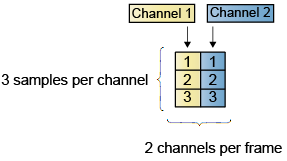ALSA Audio Capture
使用 ALSA 从声卡捕获音频
需要附加功能:此功能需要 Simulink Support Package for Raspberry Pi Hardware 附加功能。
库:
Simulink Support Package for Raspberry Pi Hardware /
Audio and Video
描述
ALSA Audio Capture 模块从连接到硬件的音频输入设备读取音频数据。该模块使用高级 Linux 声音架构 (ALSA) 驱动框架来读取音频数据。
该模块以 N×C 矩阵形式输出音频数据,其中 N 是每个音频通道的采样数,C 是音频设备支持的通道数。分别在每帧采样数(N) 和通道数(C) 参数中指定 N 和 C 的值。
注意
要将 ALSA Audio Capture 模块用于支持两个以上声道的音频设备,您必须有 Audio Toolbox™ 许可证。
在 Simulink® 模型中,您可以将 ALSA Audio Capture 模块设置为 Raspberry Pi® 硬件的调度器中断源。有关详细信息,请参阅Scheduler options。
算法
假设有一个 Simulink 模型,它包括一个 ALSA Audio Capture 模块和一个 ALSA Audio Playback 模块。在每个采样时间,ALSA Audio Capture 从连接到硬件音频输入连接器的麦克风读取立体声音频数据。该模块以 3×2 矩阵形式输出数据。ALSA Audio Playback 模块接受该音频矩阵,并将音频发送到连接到硬件音频输出插孔的耳机。

ALSA Audio Capture 模块根据每个音频通道的采样数 (N) 和采样频率 (Fs) 确定采样时间 (Ts)。
Ts = N / Fs
例如,如果 N 是 4410 个采样,而 Fs 是 44,100 Hz,则模块采样时间是 4410/44,100 = 0.1 秒。
N 是在通道数(C) 参数中指定的每个音频通道的采样数。Fs 是在音频采样频率(Hz) 参数中指定的音频数据的采样频率。
端口
输出
参数
版本历史记录
在 R2013a 中推出
